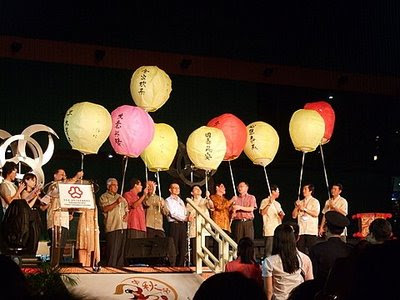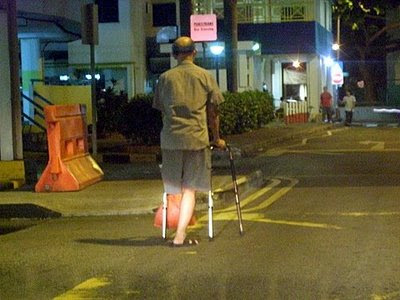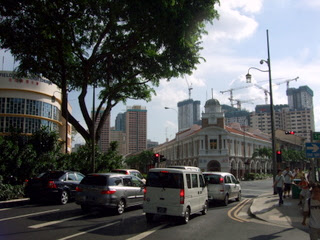














Ah, the nostalgic days ....








An interesting name, Re! In Chinese it is Re Li .. and this Re - pronounced as Swee in Hokkien -could it be part of the Chin Swee Road that runs by it?







Each day as I passed this sign which was strategically placed at the corner of Blk.34 along Upper Cross St, I could not help wondering and trying to jot my memory what it was like in my young days. Not matter how, this part of the memory seemed to be hidden deep in the vault.
But I could remember the night-soil station, somewhere around here. I am trying to pinpoint its exact spot. I could only remember vividly once visiting a schoolmate's (I could not even be sure) home (which is a residence block for the night soil carrier). Was it smelly? The sight of the "36 door lorry" could have conjured up the smell. (^^) It was tough work for the night soil carriers as they have to transport them from many houses in Chinatown which were still using the bucket system (visit the Chinatown Heritage Museum to see one real one, though not used) to the specially designed night soil carrier (in this case the truck). At this station, the carriers were washed cleaned and parked away for yet another day. The night soil clearing process seemed to be carried out in the morning.
As time and tide wait for no man, the night soil carrier also waited for no man. One could find a quick replacement while one was in the progress of one's most important function. (^^) I wonder if there is still any of these night soil carrier alive. Could well be.
The Block 32 (HDB People's Park) was built to house the stall holders after the fire at the old People's Park. The cloth sellers occupied the second storey. Until recently (even though many still manage today), many still went to find the cloth they like and then buy them to sew the clothes themselves or send to a tailor. It was often an adventure trying to buy cloth from these cloth shops. Franca Lingua is Cantonese, normally. While the shopkeeper might try his or her best Cantonese to persuade you to buy, he or she could turn to the other extreme of the colourful spectrum of colourful Cantonese to chide you for not buying. It could be heard for miles! (^^) Ah, the opening price could be sky high and one need to have the skills to bargain to a reasonable price, sometimes depending on the mood of the shopkeeper. If you are the first customer, God forbid, if you walk away without buying. Storms and thunder were sure to follow. These shopkeepers have this belief that the first sale must be successful, and they would go real low to achieve that. Imagine what happens if you are just a frivolous buyer?
I had the good fortune of sitting in a shop to watch - alas I was a poor seller, I could not put up a hard and good bargain, giving all the tall stories. (^^) But looking from inside the shop, I realised that these poor shopkeepers were often dumped with a set of say, five different colours of one patterned cloth - that's the wholesaler's offer. Of five rolls of cloth, one would be lucky if two of them sell well. I often wonder how stupid (^^) the designers could be in printing colours that the customers don't want. But then, one taste could be another's distaste. And so, to make a small profit and to cover the loss of the other possible three rolls, the shopkeeper has to try to offer at very high prices. Watch them talk and calculate at the same time. No, the schools do not teach one how to do mental sums while talking with the customers.
Some poor shopkeepers maintained a frugal life of simple food and selling not too expensive, and thanks to the low rents offered by HDB (for those affected by the fire), they could live a reasonably spartan yet comfortable life. But like in any society, these people saw how their neighbouring shops innovated by offering new wares and actually increased their income many folds. Like in any kampung (village) here, new tenants came in, paying sky high rents, and yet could still make money. And so, today if you walk through the refurbished HDB People's Park, you would see a few of such shops, manned by the second or third generation of the original stallholders of the old People's Park.
Block 34, I saw it grew as I walked home from work each evening. But somehow, I could not recall how the place looked like before this new flat was built. The two schools behind had seen its share of history. From two schools, it became one and then it was gone. A government agency took over and then left. In the foreign worker and student boom, it became a hostel. And that school left these two buildings to a mult-storey building just around the Pearl's Hill. It had seen its better days and, was gone. Thanks to the hotel squeeze, it is now a hotel!
It must have been in 1969 to early 70s when these flats along Upper Cross St were completed. Unknown to me, these flats would change the lives of many in the following years. It was to be for the relocation of the residents of Chinatown (in the Chin Chew and Upper Chin Chew St - known as Tau Foo Kai (Tofu St) consisting of mainly Cantonese and the residents of the Teochew enclave along where else, but Teochew St and there about.
Blk. 34, being 3-room flats, along with the other 1-room flats, saw the city kampongs (village) transformed from horizontal ones to vertical ones. Intra-flat traffic was high as relatives and neighbours were at different floors of the flats. Many of the residents knew each other. Instead of sitting by the five foot way each evening and chatting with neighbours, the corridors along these flats were narrow and it required a little more effort for gathering. Some older men gathered at the coffeeshop.
Over time, as some resident families expanded, they moved out. Some moved out, making a tidy sum of money, thanks to the climbing property market. Others moved in. Intra-floor traffic lessened. Strangers became more common. Children grew up and married out. For the new residents, interestingly, for them, in the lift, at best it was just a smile as a kind of recognition. Barring a nasty neighbour, one's neighbourly relationship could be only two doors away, each side. Ah, but when a baby arrives in that family, things changed. The smiles became greetings, often focussing on the baby. "Ooh, how has he grown!" Mothers were the fastest in getting to know each other and exchanging notes. From baby food it would progress to childcare centre, on to kindergarten and yes, the complicated process of getting into the school of their desire. The fathers, more often than not, smiled and maybe said "Hi".
Unlike the old kampong days, be it along a street in the city, most of the neighbourhood in the flat are not conducive for the kids to play with each other. In some neighbourhood, the playgrounds help. But given the "in-security" of flat dwellers, most parents do not allow their children to go outdoors on their own. And so, developing into a village in the flat is still a challenge.
The flats around this triangle have been around for some 30 years. These days seem to see the diminishing number of the early residents. The traditional Teochew funeral wakes, complete with traditional rituals, seem to be a regular affair. And so, one by one, the older residents bid their old neighbours goodbye. For some who were left behind in this flat while their descendants have moved elsewhere, it meant one "kaki" (friend) less for their old comrades.
But life moves on, with influx of new residents. Life in the upper floors differ from the rapid stream of people moving along the five foot way on the ground floor.
 While the nyonyas (the Peranakans) fancied more complicated kueh2, the others, depending on the dialect groups, might opt for their own. I think the Cantonese loved to make kok-jai (a mini curry puff lookalike with grounded peanuts and sugar inside). One of the more popular ones could be the "love letters". I still wonder if anyone had inserted love-letters in these thin crust. In the old days, I remember watching, and well helping out in making these thin pancake-like crust-like kueh. In Hokkien, I think it is called kuey-nern-gern (meaning rolled eggs). One spreaded a thin layer of flour dough onto the circular plated and then closing it with a similar plate, it is placed on a charcoal fire. It gets cooked easily and with a flip, it is done. The tricky part is using your hands to roll them when they are hot and still soft.
While the nyonyas (the Peranakans) fancied more complicated kueh2, the others, depending on the dialect groups, might opt for their own. I think the Cantonese loved to make kok-jai (a mini curry puff lookalike with grounded peanuts and sugar inside). One of the more popular ones could be the "love letters". I still wonder if anyone had inserted love-letters in these thin crust. In the old days, I remember watching, and well helping out in making these thin pancake-like crust-like kueh. In Hokkien, I think it is called kuey-nern-gern (meaning rolled eggs). One spreaded a thin layer of flour dough onto the circular plated and then closing it with a similar plate, it is placed on a charcoal fire. It gets cooked easily and with a flip, it is done. The tricky part is using your hands to roll them when they are hot and still soft.
 To many Cantonese at home, they would start early, probably a month or so before the Chinese New Year, to buy a few chi-ku 慈姑 (in Cantonese for arrowhead) and plant them in a shallow bowl of water and pebbles. Anyone knows its significance? Chi-ku is a favourite bulb cooked in soups by the Cantonese.
To many Cantonese at home, they would start early, probably a month or so before the Chinese New Year, to buy a few chi-ku 慈姑 (in Cantonese for arrowhead) and plant them in a shallow bowl of water and pebbles. Anyone knows its significance? Chi-ku is a favourite bulb cooked in soups by the Cantonese.

 When our kids came of age, our natural consideration was to get them to attend the kindergarten in Fairfield Church. Ah, and so, we got the opportunity to sit in what was once a cinema. But this time, it was more of a theatre, and well, a chapel, where we got to see our children performed in their graduation night.
When our kids came of age, our natural consideration was to get them to attend the kindergarten in Fairfield Church. Ah, and so, we got the opportunity to sit in what was once a cinema. But this time, it was more of a theatre, and well, a chapel, where we got to see our children performed in their graduation night. Or should it be the Year of the Mouse, the Mickey Mouse to be more accurate? (^^) Yes, Chinatown is decorated with the likes of Mickey Mouse in welcoming yet another new year. The year of the Rat starts another new cycle, and from what we know about rats - there were plenty in Chinatown - it would be tough to romanticise the rats. And so Mickey Mouse came to the rescue. A friend was wondering aloud, why not Mighty Mouse?
Or should it be the Year of the Mouse, the Mickey Mouse to be more accurate? (^^) Yes, Chinatown is decorated with the likes of Mickey Mouse in welcoming yet another new year. The year of the Rat starts another new cycle, and from what we know about rats - there were plenty in Chinatown - it would be tough to romanticise the rats. And so Mickey Mouse came to the rescue. A friend was wondering aloud, why not Mighty Mouse?




 Entering the restaurant and looking at the young people chatting away and enjoying the traditional and modern Japanese dishes, it reminded me of Japan. This restaurant was no different from any of a similar restaurant in Shibuya, Tokyo or Shinjuku. But what got me thinking was that these days, there are many Japanese eateries all over Singapore, practically at least one in every shopping centre, and probably in every food court too. When I did an informal count in 1989, we could count some 40 Sushi restaurants.
Entering the restaurant and looking at the young people chatting away and enjoying the traditional and modern Japanese dishes, it reminded me of Japan. This restaurant was no different from any of a similar restaurant in Shibuya, Tokyo or Shinjuku. But what got me thinking was that these days, there are many Japanese eateries all over Singapore, practically at least one in every shopping centre, and probably in every food court too. When I did an informal count in 1989, we could count some 40 Sushi restaurants.  My first Sashimi - ah, Maguro as I learnt much later - was indeed in the Japanese Association Restaurant. It was in 1973 or thereabout, my first encounter working with a Japanese engineer, when he invited me and my colleague to a Japanese dinner. Wah, Sukiyaki and Maguro. It was an experience trying to down the raw tuna, and eating cooked beef with raw eggs. Ask my kids now, and they would go for them without a second thought. But of course, it was Papa's fault. (^^)
My first Sashimi - ah, Maguro as I learnt much later - was indeed in the Japanese Association Restaurant. It was in 1973 or thereabout, my first encounter working with a Japanese engineer, when he invited me and my colleague to a Japanese dinner. Wah, Sukiyaki and Maguro. It was an experience trying to down the raw tuna, and eating cooked beef with raw eggs. Ask my kids now, and they would go for them without a second thought. But of course, it was Papa's fault. (^^)